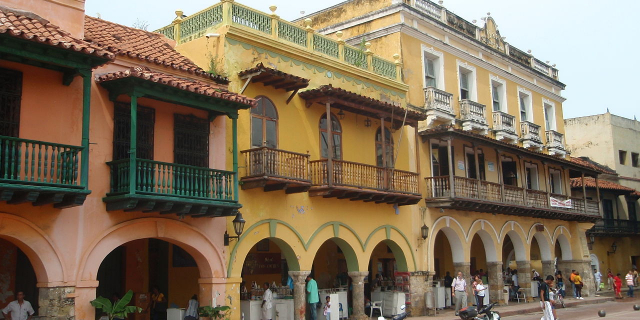Ciudad Perdida
Ciudad Perdida (Spanish for "lost city"; also known as Teyuna and Buritaca-200) is the archaeological site of an ancient city in the Sierra Nevada de Santa Marta of Colombia, within the jurisdiction of the municipality of Santa Marta. This city is believed to have been founded about 800 AD. If so, Ciudad Perdida predates Machu Picchu by about 650 years.
Ciudad Perdida consists of a series of 169 terraces carved into the mountainside, a network of tiled roads, and several small circular plazas. The entrance can be accessed only by climbing up 1,200 stone steps through dense jungle.
 Boulder with carved markings, believed to be a map of Ciudad Perdida and paths connecting it to the larger area (see Lost Cities with Albert Lin, S1 E3, "El Dorado, City of Gold")
Boulder with carved markings, believed to be a map of Ciudad Perdida and paths connecting it to the larger area (see Lost Cities with Albert Lin, S1 E3, "El Dorado, City of Gold")Built around 800 CE,[1] Ciudad Perdida was most likely the region's political and manufacturing center on the Buritaca River and may have housed 2,000–8,000 people. The site was originally inhabited by the Tairona people. According to the Kogi people, who are some of the last preserved indigenous descendants of the Tairona, the Tairona lived for thousands of years, up until the age of the Spanish conquistadors.
The Tairona people were forced to flee from La Ciudad Perdida sometime in the 16th century,[2] after years of trade and conflict.
Indigenous tribesIndigenous peoples had established advanced communities 1,500 years before the Spanish arrived. These communities were connected by stone paths, which facilitated the exchange of food and products made of gold, stone, and clay. The inhabitants took advantage of the rich variety of foods and resources available in this mountainous region near the sea. They had gardens to grow vegetables such as tomatoes and corn, and fruits such as avocado, guanabana, pineapple, and guava. Due to their close proximity to the ocean, they obtained a large variety of seafood. The indigenous children learned the stories and legends from their elders and were taught how to create fabrics to make their clothes and mochilas. Children and adults admired the warriors who successfully protected the indigenous people from the Spanish conquerors.
Although they are generally referred to as the "Tairona people", there were many groups and settlements spread across the mountains and beaches in distinct, smaller communities (polities) all trading and working together. When the Spanish landed on their territory in 1514, the conquistador took out his declaration and read,[3]
I assure you, that with the help of God, I will make war on you in every place, and in every way, I can and I will subject you to the yoke and obedience of the church and their highnesses and I will take your persons and your women and your children and I will make them slaves and I will take your goods and do you all the evils and harms which I can.
The Tairona people were strong warriors and resisted the oppression of the conquistadors for nearly a century. For many years after the Spanish arrived on their shores, the Tairona were able to hold their ground despite violent treatment from Europeans. The Tairona people, much like the Kogi people today, were not violent people. The Kogi believe in kindness and equality. The Tairona people lived to protect and serve the earth, not only for themselves but for everyone.
As the European colonizers settled in indigenous territory, they began enslaving the natives who fished and collected salt on the coast. The Tairona people in the mountains, dependent on the fish and salt farmed by the coastal Tairona people, told escaped enslaved Tairona members to return and bring the Europeans gifts of gold to appease them. The Europeans took the gold but were not appeased and became more hostile to the natives. The Tairona resisted the conquistadors for many years (the exact number of years is unknown) but were eventually forced to flee in the 1500s.
The effects of the conquistador's colonization of their villages are still seen today. As the years passed, the Europeans took more and more of the gold originally crafted by the indigenous people. Much of that gold still resides in museums across Europe, leaving the current descendant tribes of today—the Kogi, Arsarios, Arhuacos, Kankwamos, and Chimilas—without any of the gold of their ancestors.
The Kogi people live in the last pre-Columbian settlement and have more-or-less kept the ways of the Tairona people since they were forced out of their settlements by the conquistadors. Although the Kogi can provide insight into the Tairona, it is important to remember that they are distinct from the people who lived 500 years ago. The Kogi people believe that everything buried in La Ciudad Perdida contributes to the peace, harmony, and balance of the world. After teaching one of their members Spanish, they presented this case to the Colombian government and successfully reclaimed the rights to their ancestral land. Now, groups like the Global Heritage Fund continuously work to protect the historic site against, as the Kogi people would say, "younger brother's" harm.






























Comments
Great experience with Teyuna…
Great experience with Teyuna Tours ( https://teyunatours.com/), company founded by local guides I absolutely recommend!
Add new comment